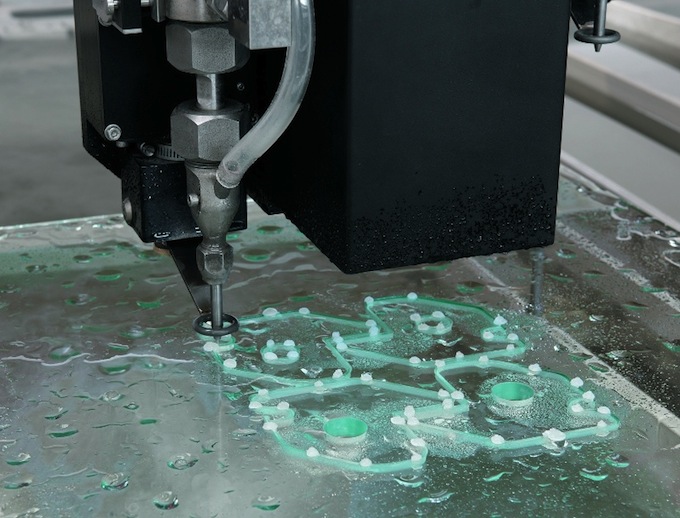
Waterjet technology has been around for decades, playing a key role in the success of various sectors in the manufacturing industry. Using water to make precision cuts remain a popular option for businesses today despite the presence of other options such as laser and plasma cutting.
How Does It Work?
Contrary to what its name suggests, waterjet cutting doesn’t actually cut the material. The high-pressure stream of water literally pushes part of the material clean off, basically eroding it at a very high speed. A waterjet’s “cutting” power depends on the amount of pressure in the stream; the higher the pressure, the tougher materials it can cut. Typical waterjet cutting machines feature servo pumps that are capable of producing streams of 50,000 psi or higher—plenty of power to cut through various materials.
Simply having enough pressure isn’t enough; to make a successful “cut,” the waterjet has to be moved just fast enough to allow the water to erode the material all the way through. Depending on the cut pattern, this may require a high degree of precision and timing. Instead of being directed manually, a waterjet cutting machine is usually programmed to perform specific cutting patterns. A series of high-precision stages direct the nozzle to the right position.
Precision and Power
Despite involving the use of immense pressure, waterjet cutting is a good option if precision is a top priority. A properly calibrated waterjet cutting machine can be programmed using special software to perform precise cutting patterns that are accurate down to .005 inches. Waterjet cutting also has an advantage over plasma and laser cutting because it doesn’t generate heat, preventing warping or distortions that can affect the integrity of the material.
Waterjet cutting is also versatile, by changing the size of the stream. This is perfect for creating engravings or cuts that have to be a specific size. Depending on the cut pattern, a waterjet cutting machine may change the stream size two or more times when working on a single sheet of material.
Common Applications of Waterjet Cutting Technology
Waterjet cutting is an incredibly versatile method, being a viable option for most types of materials used in fabricating parts. In fact, waterjet cutting is the best option forsome materials such as ceramics and cork, which could get burned by laser or plasma cutting. Waterjet cutting even works on stronger materials such as titanium plates and stainless steel.
Thanks to its sheer versatility, waterjet cutting have a wide variety of applications across different kinds of businesses in the manufacturing industry. Here are a few examples:
Art and Signage – Waterjetcutting can be used to cut out letters and shapes that can be utilized for making signs of different sizes. These can be used for both residential and commercial purposes.
Car Manufacturing – Manufacturing a car’s body involves cutting fiberglass or metal panels to the right contour before being painted over or installed. Certain metal components in the car may also have to be fabricated within the same production plant which means a highly adjustable waterjet cutting machine will come in handy.
Footwear and Clothing-Soles can be cut out of large sheets of rubber that could get snagged on mechanical cutters, saving time and minimizing waste due to damaged rubber. Waterjet cutting also keeps rubber and leather used in jackets from getting frayed along the cut—a common issue with conventional cutters or saws.
Tile Manufacturing – Floor tiles have to be cut into uniform shapes in order to look good when installed. Programming the machine to make repeated cutting patterns makes it easier to produce bigger batches of tiles for covering even large floor spaces.
There are several types of waterjet cutting technologies, most notably plain and abrasive water jets. Constant efforts on the development of the technology may lead to the development of more precise and energy-efficient options. While the future demands of industrialization are not yet certain, waterjet cutting technology has already secured its place as one of the most important tools in the manufacturing industry.
 Techosta Where Tech Starts From
Techosta Where Tech Starts From